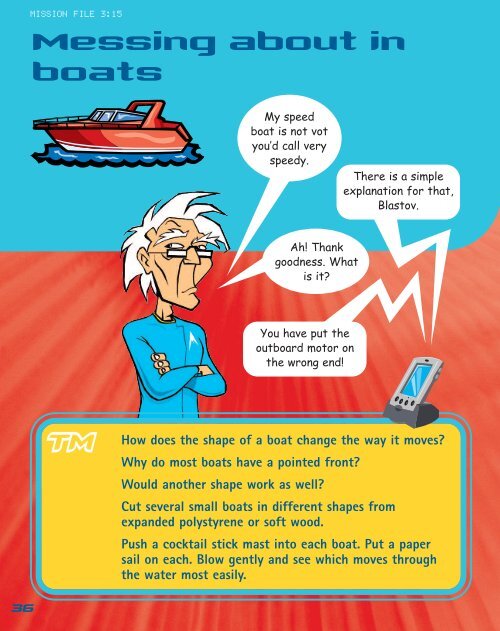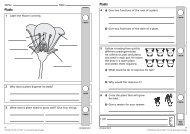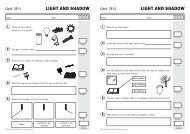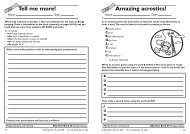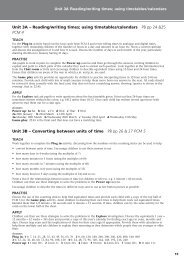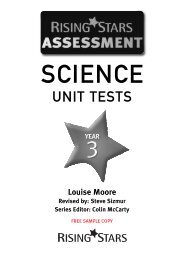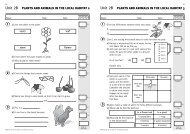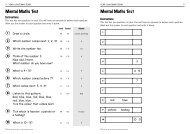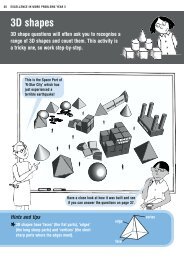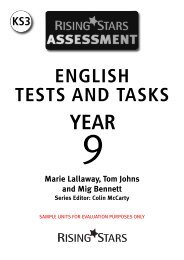Messing About in Boats - Rising Stars
Messing About in Boats - Rising Stars
Messing About in Boats - Rising Stars
Create successful ePaper yourself
Turn your PDF publications into a flip-book with our unique Google optimized e-Paper software.
<strong>Mess<strong>in</strong>g</strong><br />
MISSION FILE 3:15<br />
about <strong>in</strong><br />
boats<br />
My speed<br />
boat is not vot<br />
you’d call very<br />
speedy.<br />
There is a simple<br />
explanation for that,<br />
Blastov.<br />
Ah! Thank<br />
goodness. What<br />
is it?<br />
You have put the<br />
outboard motor on<br />
the wrong end!<br />
36<br />
TM<br />
How does the shape of a boat change the way it moves?<br />
Why do most boats have a po<strong>in</strong>ted front?<br />
Would another shape work as well?<br />
Cut several small boats <strong>in</strong> different shapes from<br />
expanded polystyrene or soft wood.<br />
Push a cocktail stick mast <strong>in</strong>to each boat. Put a paper<br />
sail on each. Blow gently and see which moves through<br />
the water most easily.
M1<br />
Water resists objects mov<strong>in</strong>g through it.<br />
Streaml<strong>in</strong><strong>in</strong>g, smooth<strong>in</strong>g and polish<strong>in</strong>g the<br />
objects will reduce their friction with the water.<br />
Fix a thread to the front of each boat. Pull each<br />
through the water.<br />
How will you measure the pull force? Could you<br />
use a th<strong>in</strong> elastic band?<br />
Record the pull needed for each boat shape.<br />
Aha! Zat is<br />
better. Now let’s<br />
see vot zis baby<br />
can do!<br />
Better untie it<br />
from the moor<strong>in</strong>g<br />
first, Victor…<br />
Da V<strong>in</strong>ci files<br />
For many small animals,<br />
swimm<strong>in</strong>g <strong>in</strong> water must be<br />
like push<strong>in</strong>g though syrup;<br />
and the same is true of some<br />
small <strong>in</strong>sects fly<strong>in</strong>g through<br />
the air... How is it possible<br />
that you could actually swim<br />
faster through syrup than<br />
through water?<br />
ANALYSE<br />
THIS!<br />
Does the size<br />
of its wheels<br />
affect a<br />
vehicle’s speed?<br />
37
MISSION FILE 3:15<br />
<strong>Mess<strong>in</strong>g</strong> about <strong>in</strong> boats<br />
Mission title:<br />
QCA scheme of work:<br />
Resources:<br />
Class organisation:<br />
<strong>Mess<strong>in</strong>g</strong> about <strong>in</strong> boats<br />
Unit 4D Solids, liquids and how they can be separated<br />
Thread, paper, forcemeter, balsa wood or other float<strong>in</strong>g material, Internet<br />
access<br />
Individual/group/class.<br />
Knowledge review<br />
Introduc<strong>in</strong>g the mission<br />
Teacher’s notes<br />
Further extension<br />
for children<br />
Useful websites<br />
A streaml<strong>in</strong>e is a l<strong>in</strong>e that is parallel to the flow of water. Streaml<strong>in</strong>ed shapes<br />
have sides that are as close to parallel to the flow of water as possible.<br />
Animals and vehicles are said to be streaml<strong>in</strong>ed if their shape allows water<br />
and/or air to move past them efficiently. Smooth sides reduce friction, sides<br />
parallel to the air and/or water flow allow easy movement and a po<strong>in</strong>ted front<br />
end reduces the amount of resistance encountered by direct<strong>in</strong>g air and/or water<br />
down the sides of the shape rather than aga<strong>in</strong>st the front of it.<br />
Swimm<strong>in</strong>g <strong>in</strong> syrup is as easy as swimm<strong>in</strong>g <strong>in</strong> water, even when the syrup is<br />
twice as thick as water. This is because there is more thrust from push<strong>in</strong>g aga<strong>in</strong>st<br />
the thicker liquid and it cancels out the extra resistance the body encounters. The<br />
test was carried out at the University of M<strong>in</strong>nesota. For t<strong>in</strong>y water animals,<br />
swimm<strong>in</strong>g through water must be the equivalent of a human swimm<strong>in</strong>g through<br />
syrup; yet they still make good progress.<br />
Discuss how th<strong>in</strong>gs move through water. Expla<strong>in</strong> that the children are go<strong>in</strong>g to<br />
<strong>in</strong>vestigate ways to make mov<strong>in</strong>g through water easier.<br />
• Test<strong>in</strong>g the boats could be messy – use a wet area or go outside.<br />
• Make sure the boats are stable and have enough weight to sit <strong>in</strong> the water<br />
while they are pulled.<br />
• Th<strong>in</strong>k about different animals that live <strong>in</strong> water and work out how their body<br />
shapes are adapted to help them move easily through the water.<br />
• Does a streaml<strong>in</strong>ed shape for a paper plane mean that it flies further?<br />
Investigate.<br />
http://www.bbc.co.uk/schools/ks3bitesize/science/physics/forces_motion_8.shtml<br />
describes what be<strong>in</strong>g streaml<strong>in</strong>ed means.<br />
http://news.bbc.co.uk/1/hi/magaz<strong>in</strong>e/4801670.stm for more about swimm<strong>in</strong>g <strong>in</strong><br />
syrup.<br />
Bra<strong>in</strong> Academy Science Teachers Book 55


